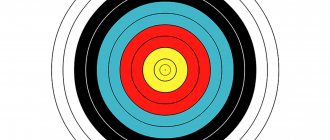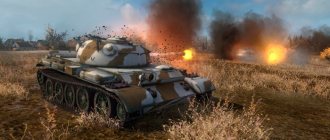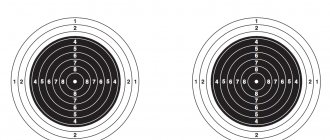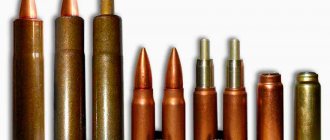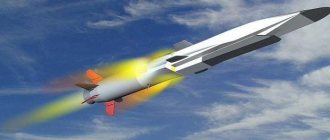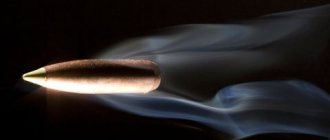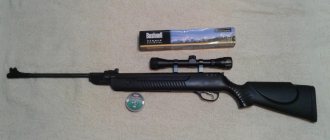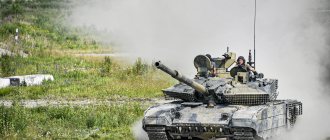Reality of shooting
The concept of the reality of shooting
When firing from small arms and grenade launchers, depending on the nature of the target, the distance to it, the method of firing, the type of ammunition and other factors, different results can be achieved. To select the most effective method of performing a fire mission under given conditions, it is necessary to evaluate the fire, i.e. determine its reality.
Firing validity is the degree to which the firing results correspond to the assigned fire mission. It can be determined in advance by calculation or based on the results of experimental shooting.
Knowledge of the patterns and characteristics of dispersion, possible errors in the preparation of initial data and some other shooting conditions allows us to determine in advance by calculation the expected results of shooting.
To assess the possible results of firing from small arms and grenade launchers, the following indicators are usually accepted:
— probability of hitting a single target (consisting of one figure);
— mathematical expectation of the number (percentage) of struck figures in a group target (consisting of several figures);
— mathematical expectation of the number of hits;
- average expected consumption of cartridges (grenades) to achieve the required firing reliability;
— average expected time spent on performing a fire mission.
In addition, when assessing the validity of the shooting, the degree of lethal and penetrating effect of the bullet (grenade) is taken into account.
The lethality of a bullet is characterized by its energy at the moment it hits the target. To injure a person (incapacitate him), energy equal to 10 kgm is sufficient. A small arms bullet retains its lethality almost up to the maximum firing range.
The penetrating effect of a bullet (grenade) is characterized by its ability to penetrate an obstacle (shelter) of a certain density and thickness. The penetrating effect of a bullet is indicated in the shooting manuals for each type of weapon. A cumulative grenade for grenade launchers penetrates the armor of any modern tank, self-propelled artillery unit, or armored personnel carrier.
When determining the validity of shooting experimentally, the number (percentage) of hits on a single target, the number (percentage) of hit figures in a group target, the degree of penetrating or lethal action of a bullet (grenade), the consumption of ammunition and time for shooting or hitting one target (figures) are usually taken into account ).
To calculate indicators of the validity of shooting, it is necessary to know the characteristics of the dispersion of bullets (grenades), errors in the preparation of shooting, as well as methods for determining the probability of hitting a target and the probability of hitting targets.
Errors in preparation for shooting include errors in the technical preparation of weapons (in bringing it to normal combat, alignment of sighting devices, tolerances in the manufacture of mechanisms, etc.) and errors in preparing the initial settings for shooting (in determining the distance to the target, taking into account corrections for deviations of shooting conditions from normal, in rounding when assigning settings, etc.).
Note. A measurement error, or simply an error in probability theory, is the difference between the obtained measurement result and the true value of the measured quantity.
If the value of the measured quantity is unknown, then the average result of individual measurements is taken as the unknown true value of the measured quantity.
The average result is the quotient of dividing the sum of the measurement results, taken with their signs, by the number of measurements.
Errors can be positive when the measured value is greater than the true value, and negative when the measured value is less than the true value.
Errors can be systematic or random.
Systematic (permanent) errors are caused by constantly operating causes, have the same impact on all measurements and can be taken into account. For example, due to the displacement of the front sight on a Kalashnikov assault rifle to the left by 0.5 mm, bullets at a firing range of 100 m deviate from the aiming point to the right by 13 cm. It is enough to move the front sight to the right by 0.5 mm, and the error will be eliminated.
Random errors are those that are the result of a large number of error sources and with each new measurement (test) they receive new, random values. Random errors cannot be taken into account and corrections cannot be introduced in advance to eliminate them. An example of the effect of random errors is the dispersion of bullets (grenades).
In the distribution or frequency of occurrence of random errors with a large number of measurements (tests), a certain pattern appears, which is usually called the normal law of random errors. This pattern is expressed by the following basic provisions.
Errors in preparation for shooting lead to deviation of the average trajectory from the middle of the target (intended point). These deviations are random both in direction and in magnitude, but they are subject to the same laws as the deflection of bullets (grenades) due to dispersion. The total (total) area of dispersion of bullets (grenades) will be determined by dispersion and possible deviations of average trajectories due to errors in preparation for firing (Fig. 41). Therefore, when determining the validity of shooting, taking into account errors in shooting, it is necessary to take the size of the total (reduced) median deviations, combining the center of the total dispersion with the middle of the target.
Dependence of the reality of shooting on various reasons
The validity of the shooting depends on the method of firing, the firing range, the nature of the target, observation conditions, the degree of training of the shooters and a number of other reasons.
Fire from small arms is most effective from a standing position (lying down, standing from a trench, etc.) - but this does not mean that these positions should be the main ones. When choosing a shooting method, you must be guided by the current situation.
As the firing range increases, the actuality of fire decreases. This is explained by the fact that with increasing range, dispersion increases, errors in preparation for shooting increase, and the probability of a hit decreases.
The larger the target and the better the observation conditions, the more effective the shooting. If the target fires back, then the time for shooting is reduced, errors in aiming and in the preparation of fire increase and, consequently, the effectiveness of shooting decreases.
A better trained shooter makes fewer mistakes in preparing to shoot and aiming the weapon, which leads to an increase in the probability of a hit and the actual shooting.
When a unit fires at lines, at masks, in conditions of limited visibility, the effectiveness of fire increases with increasing fire density.
Fire density is the number of bullets per linear meter of a certain line fired by a unit per unit of time (per minute) from all types of weapons.
The density of fire depends on the number of weapons, their types and combat rate of fire and on the width of the area over which fire is fired.
The combat rate of fire of a weapon is the number of shots that can be fired per unit of time (per minute) with precise execution of shooting techniques and rules, taking into account the time required to reload the weapon, adjust and transfer fire from one target to another.
The technical rate of fire (rate of fire) of an automatic weapon is the number of shots of continuous fire that a given type of weapon can produce per unit of time.
Signs of actual fire are: visible damage to the target and a change in the enemy’s behavior (cessation of movement, movement of the target to a sheltered place, confusion in the enemy’s battle formation, weakening or cessation of enemy fire).
Signs indicating the low validity of one’s own fire are: absence of losses from the enemy, well-aimed, organized enemy fire, non-stop movement of the enemy, etc.
Depending on the degree of destruction inflicted on the enemy, small arms can be used: fire to destroy and fire to suppress the target.
Fire to destroy a target consists of inflicting such a defeat on it that it completely loses its combat effectiveness. Destruction of the target is achieved when the probability of hitting the target (mathematical expectation of the number of struck pieces) is at least 80%.
Suppressive fire involves inflicting damage on a target that temporarily deprives it of combat capability, limits or prohibits maneuver, and disrupts control. Target suppression is achieved when the probability of hitting the target (mathematical expectation of the number of affected figures) is at least 50%.
Shooting Basics: Bullet Flight Factors
Not every shooter is a sniper. But, as you know, every sniper is a shooter. What factors should you consider when shooting to ensure that the bullet hits exactly where you want it?
To the normal eye, the scope on a rifle may appear to be parallel to the barrel. Actually this is not true. The axis of the barrel and the optical axis of the sight form an angle called the aiming angle. And the trajectory of the bullet, of course, is not straight, and the target is not always at the same level as the rifle - you often have to shoot at significant elevation or declination angles. In flight, the bullet is affected by gravity and various aerodynamic forces, which must be taken into account when aiming.
GRAVITY WHEN A BULLET FLYS
The effect of gravity on the flight of a bullet is assessed quite simply. Over a certain time (or at a certain distance), the bullet decreases, and this decrease, depending on the firing distance, can be calculated using a ballistic calculator or from tables, and then adjusted using the appropriate handwheel of the sight. As a rule, flywheels are graduated in angles - in the West minutes of angle (MOA) are accepted, in Russia - thousandths of a distance, or milliradians (transverse dimension of 1 m at a distance of 1000 m, 1 mrad = 3.43 MOA) . To make the task easier, flywheels are sometimes calibrated in distance meters (this adjustment will work for a specific ammunition under standard conditions).
DISTANCE TO TARGET
Correct determination of the distance is extremely important for accurate shooting. There are many methods for this - from using a laser rangefinder or comparing an aiming reticle with known object sizes to basic signs such as “the movements of a person’s arms and legs are distinguishable from 500–600 m.” There are also a number of situations that make it difficult to correctly visually determine distance. The greater the firing distance, the greater the error in determining the distance will affect the final result - the possibility of hitting the target.
WIND WHEN SHOOTING
Air resistance slows down a flying bullet, and this must be taken into account when calculating corrections (especially in unusual situations - for example, in mountainous areas, when the air is thin). Humidity and air temperature also have an effect. But much more important is the aerodynamic drift of the bullet by the side wind. The fact is that when shooting over long distances (several hundred meters) along the bullet’s flight path, the wind can change several times - both in strength and direction. In the city, high-rise buildings create powerful air currents that seriously complicate the work of police snipers during special operations. The speed and direction of the wind have to be determined by fluctuations in rising air currents - mirages - or even completely predicted. A sniper saying goes: “Novices study ballistic tables, but seasoned snipers study the wind.”
DERIVATION
The point of application of gravity to the bullet (center of mass) does not coincide with the point of application of aerodynamic forces (center of pressure, located in front of the center of mass). As a result of the action of these forces, an overturning moment occurs in the trajectory plane. But since the bullet rotates and is a gyroscope, its axis of rotation is deflected perpendicular to the plane. That is, if the bullet rotates to the right, it deflects to the right and precession occurs - vibrations in the axis of rotation of the bullet. The axis of this precession will be deflected to the right, aerodynamic forces deflect the flight of the bullet in the same direction. This phenomenon is called derivation. It depends on the speed of the bullet and its rotation speed, mass and shape. Typically, this effect begins to affect shooting accuracy only at fairly large distances (where it is most likely to be “lost” against the background of much more significant wind drift).
THE MAGNUS EFFECT
Since the bullet rotates in flight, during a crosswind it can be affected by the Magnus effect, which consists in the fact that when an air flow flows around a rotating body, a force directed perpendicular to the flow movement acts on the body. On the side of the bullet where the direction of rotation coincides with the direction of the flow, the speed of air movement increases, on the other it decreases. The pressure difference produces a force directed in the direction where the direction of rotation and the direction of air flow coincide. The Magnus effect does not have a noticeable effect on practical shooting results, so it is usually neglected.
UP AND DOWN
As a separate case, it is worth considering shooting adjusted for the target elevation angle. This situation occurs in the mountains or in the city, where snipers set up positions on the roofs of buildings. When shooting at a target located above or below the shooter, it is necessary to make a correction, which depends on the elevation angle, but does not depend on whether the angle is positive or negative - in both cases, when a normal correction is introduced, the bullet will pass above the target. Shooting at an angle to the horizon requires a smaller correction than usual. The fact is that the absolute decrease in the bullet’s flight path to the barrel line is always considered perpendicular to the horizon, and the relative decrease (the bullet’s flight path to the aiming line) is always considered perpendicular to the aiming line.
THROUGH THE GLASS
Quite often, police snipers have to deal with a situation where a terrorist who has taken hostages is behind a transparent barrier - glass. You can aim at him, but will you be able to hit him? It would seem that glass is a fragile material, but it can significantly affect the shooting result. On this score, snipers express several thoughts. Firstly, it all depends on the thickness and material of the glass. Secondly, you should not use expansive bullets, which tend to change their trajectory in an unpredictable way when passing through solid obstacles. Thirdly, a shot perpendicular to the glass has less effect on the trajectory of the bullet. Some types of glass produce many sharp fragments that can harm not only the terrorist, but also the hostages. A method often used is when one of the police snipers breaks the glass with a shot, and his colleagues hit the target almost without a pause.
WHAT TO SHOOT?
The properties of the cartridge and bullet matter in sniper business no less than the advantages of the barrel or sight. Therefore, when speaking about high-precision small arms, we mean the “rifle-ammunition” system. There are many varieties of sniper ammunition available, varying in caliber, cartridge length, bullet design, and propellant characteristics, but the real workhorse is the .308 Winchester, also known as the 7.62 NATO. We are talking about “match” class cartridges, produced on precision equipment with minimal tolerances. The bullets used in this type of ammunition are designated by the English abbreviation BTHP (Boat-Tail Hollow Point). The term boat-tail refers to the bullet's characteristic conical tail. The tail cone, by reducing the leading part of the bullet, thereby improves its aerodynamic characteristics, reduces speed loss and increases resistance to side winds. The bullet also has a cavity in the head (hollow point) - this enhances the lethal effect. 168-grain .308 Winchester sniper cartridges with BTHP bullets are produced by Remington, Hornady, Lapua, Norma, Federal, and others. .223, .300, and even half-inch .50 caliber cartridges (for large caliber rifles) are also used in sniper business.
ENERGY SAVING
Typically, snipers use specially designed “match” grade ammunition. But sometimes you have to work with other types of bullets, the properties of which are important to take into account when shooting. Bullets of the “fragile” type, upon contact with the target, crumble into small fragments, the penetration ability of which is very small. Almost 100% of the bullet's energy is transferred to the target. These bullets were created specifically for security agents accompanying flights. When hitting a terrorist, the “fragile” bullet does not penetrate right through and, in the event of an accidental hit, is not capable of piercing the fuselage of the aircraft or injuring others. Expansive bullets “open up” when they hit a target, releasing up to 70% of the energy, which also reduces the risk of hitting through. Due to its shape, a bullet from a general purpose cartridge gives off the least amount of energy (about 50%). The risk of passing right through in this case is quite high.
Tips for a sniper
1. The barrel must not come into contact with anything! 2. Press the trigger with the most sensitive part of the index finger. 3. To set the position of the stock, place a bag of sand under the butt. By pressing on it with your non-firing hand, you can make fine adjustments in height. 4. The distance between the eye and the eyepiece must be precisely maintained in order to see the entire visual field completely and without distortion. Typically this value is 7–10 cm. 5. If time permits, it is necessary to secure the position of the rifle with a belt. 6. Do not let the weapon fall down. 7. It is better to use a sandbag rather than a standard bipod as a stop.
Match class ammunition
To maximize the capabilities of high-precision sniper rifles, ammunition with increased accuracy, so-called match-grade ammunition, is required. They are produced on precision equipment with minimal tolerances. Particular attention should be paid to the design of the bullet. It is distinguished by a conical tail section in the shape of a “boat stern” and a cavity in the bow of the shell that is not filled with lead.
Breathe and shoot
When breathing, it is important not to disturb the stable position of the rifle. Therefore, it is best to fire while exhaling, with empty lungs, when the sniper can “freeze” for a few seconds. To extend the pause between breaths, the shooter must take two deep breaths before firing to saturate the blood with oxygen. However, when seconds count, the sniper may simply not have enough time to take two deep breaths. Then the “freezing” technique is used - with the lungs filled by half or three-quarters.
Scheme of shooting at an angle to the horizon
The dashed line shows the absolute drop of the bullet at a given distance. Without making special adjustments, the bullet will hit higher than the target.
According to the ballistic curve
Gravity acts on a flying bullet in the same way as it does on any falling object. During the flight, the bullet decreases significantly, which can lead to a miss. The reduction can be calculated from tables or using a ballistic calculator, but the distance must be accurately determined.
Train your eye!
The good old “thumb method” allows you to quickly estimate the distance
There are a number of situations when visual determination of distance, even with a trained eye, can give an error. In some cases, objects may appear closer: in low places hidden behind hills, when viewed from above, along long straight landmarks such as rails, or against a contrasting, uniform background such as snow or sand. In other cases, objects may appear further away than they actually are: against the background of large objects and structures, when looking up, in a narrow space or in a visible depression.
Energy saving
Typically, snipers use specially designed “match” grade ammunition. But sometimes you have to work with other types of bullets, the properties of which are important to take into account when shooting. Bullets of the “fragile” type, upon contact with the target, crumble into small fragments, the penetration ability of which is very small. Almost 100% of the bullet's energy is transferred to the target. These bullets were created specifically for security agents accompanying flights. When hitting a terrorist, the “fragile” bullet does not penetrate right through and, in the event of an accidental hit, is not capable of piercing the fuselage of the aircraft or injuring others. Expansive bullets “open up” when they hit a target, releasing up to 70% of the energy, which also reduces the risk of hitting through. Due to its shape, a bullet from a general purpose cartridge gives off the least amount of energy (about 50%). The risk of passing right through in this case is quite high.
Accuracy and accuracy of shooting, ways to improve them
The reasons causing bullet dispersion (decreased shooting accuracy) can be summarized into three groups:
- reasons causing diversity in initial velocities;
- the reasons causing the variety of throwing angles and firing directions;
- reasons causing a variety of bullet flight conditions.
The reasons causing the variety of initial speeds are:
- diversity in the weight of powder charges and bullets, in the shape and size of bullets and cartridges, in the quality of gunpowder, in loading density, etc. as a result of inaccuracies (tolerances) in their manufacture;
- variety of charge temperatures, depending on air temperature and unequal time spent by the cartridge in the barrel heated during firing;
- diversity in the degree of heating and in the quality of the barrel.
These reasons lead to fluctuations in the initial speeds, and, consequently, in the flight ranges of bullets, that is, they lead to the dispersion of bullets over range (height) and depend mainly on ammunition and weapons.
The reasons for the variety of throwing angles and shooting directions are:
- variety in horizontal and vertical aiming of weapons (errors in aiming);
- a variety of take-off angles and lateral displacements of weapons resulting from non-uniform preparation for firing, unstable and non-uniform holding of automatic weapons, especially when firing in bursts, incorrect use of stops and non-smooth trigger release;
- angular vibrations of the barrel when firing automatic fire, resulting from the movement and impacts of moving parts and the recoil of the weapon.
These reasons lead to the dispersion of bullets in the lateral direction and range (height). They have the greatest influence on the size of the dispersion area and mainly depend on the training of the shooter.
The reasons causing the variety of bullet flight conditions are:
- variety in atmospheric conditions, especially in the direction and speed of the wind between shots (bursts);
- variation in the weight, shape and size of bullets, leading to a change in the magnitude of the air resistance force.
These reasons lead to an increase in dispersion in the lateral direction and along the range (height) and mainly depend on the external shooting conditions and on the ammunition. With each shot, all three groups of causes act in different combinations. This leads to the fact that the flight of each bullet occurs along a trajectory different from the trajectory of other bullets. It is impossible to completely eliminate the causes that cause dispersion, and, consequently, to eliminate dispersion itself. However, knowing the reasons on which dispersion depends, you can reduce the influence of each of them and thereby reduce dispersion or, as they say, increase the accuracy of fire. Reducing the dispersion of bullets is achieved by excellent training of the shooter, careful preparation of weapons and ammunition for shooting, skillful application of shooting rules, correct preparation for shooting, uniform buttstock, accurate aiming (aiming), smooth release of the trigger, stable and uniform holding of the weapon when shooting, as well as proper maintenance of weapons and ammunition.
Shooting accuracy and ways to improve it
Firing accuracy is determined by the accuracy of alignment of the midpoint of impact with the intended point on the target and the amount of dispersion. Moreover, the closer the average point of impact is to the intended point and the smaller the dispersion of the bullets, the better the shooting accuracy. Shooting is recognized as a mark if the average point of impact deviates from the intended point on the target by no more than half a thousandth of the firing range, which corresponds to the permissible deviation of the average point of impact from the control point when bringing the weapon to normal combat, and the dispersion does not exceed the table norms. Firing accuracy is ensured by accurately bringing the weapon to normal combat, careful conservation of weapons and ammunition, and excellent training of the shooter. To improve shooting accuracy, the shooter must be able to determine the distance to the target, take into account the influence of meteorological conditions on the flight of the bullet and, accordingly, select the settings of the sight, rear sight and aiming point, correctly perform shooting techniques, and carefully conserve weapons and ammunition. The main reasons that reduce shooting accuracy are the shooter's errors in choosing the aiming point, installing the sight and rear sight, in readiness, in aiming the weapon and in firing. If the sight and rear sight are installed incorrectly, as well as the aiming point is chosen incorrectly, the bullets will overshoot the target (miss the target) or deviate away from it. When the weapon is stalled, the average point of impact deviates in the direction of the weapon stall and downward. When the stop is located in front of the center of gravity of the weapon (closer to the muzzle), the middle point of impact is deflected upward, and when the stop is located behind the center of gravity of the weapon (closer to the butt) it is deflected down; changing the position of the stop during shooting leads to an increase in dispersion. If the butt rests on the shoulder with the lower angle, then the middle point of impact deviates upward, and if with the upper angle, then it deviates downward. With a large front sight (the front sight is higher than the edges of the sight slot), the middle point of impact deviates upward, and with a small front sight, it deviates downward. The front sight, held to the right wall of the sight slot, leads to a deviation of the middle point of impact to the right, and the front sight, held to the left wall of the sight slot, leads to its deviation to the left. Uneven aiming leads to increased bullet dispersion. An unsmooth trigger release (jerking) usually entails a deviation of the midpoint of impact to the right and down. Firing accuracy is reduced due to various malfunctions of weapons and ammunition. So, for example, if the aiming bar and barrel are bent, the midpoint of impact deviates towards the bent side; when the front sight is bent and there are nicks in the muzzle, the average point of impact deviates in the direction opposite to the bend (nick). When the scope rolls sideways, the barrel bore is damaged and chafed due to improper cleaning of the weapon, the barrel, bayonet, machine tool, bipod, etc. roll, the dispersion of bullets increases and the position of the midpoint of impact changes. Differences in the weight characteristics of ammunition affect shooting accuracy by changing the position of the midpoint of impact and increasing the dispersion of bullets. Shooting accuracy is influenced by lighting and meteorological conditions. For example, if the sun shines from the right side, then a reflection appears on the right side of the front sight, which the shooter, when aiming, mistakes for the side of the front sight; in this case, the front sight will be deflected to the left, causing the bullets to deflect to the left. A side wind blowing from the right deflects the bullet to the left, and a wind from the left deflects it to the right.
Bad bullets
Most accuracy problems occur among owners of .177 caliber airguns with muzzle velocities over 300 m/s. Chasing speed
many manufacturers use bullets that are too light to achieve the desired stated velocity and increase the gun's rating. Unfortunately, this bullet is not the best bullet for this rifle in terms of accuracy, energy, and velocity retention. For Magnum class air rifles with a stated velocity of 300 m/s, it is not advisable to use bullets lighter than 8.0 grains. When fired, this bullet leaves the barrel at supersonic speed, then, losing speed, passes the sound barrier. The shock caused by passing the sound barrier causes the bullet to tumble and, as a result, reduce accuracy. Bullets that work in one type of rifle may not work in another.
Buy several types of pellets in your caliber and see which ones shoot the best groups at your normal shooting range. Accuracy problems caused by bullets can be easily identified by shooting groups of bullets of different types and brands. Do not use old or oxidized bullets or deformed bullets - discard them immediately. Try to use only high-quality lead bullets from reputable manufacturers. Cheap bullets are not the best savings!
Methods for determining the position of the midpoint of impact
One of the significant factors influencing shooting results is the quality of checking the weapon’s combat and bringing it to normal combat. Therefore, checking the combat of a weapon and bringing it to normal combat must be carried out with special care and precision.
The weapon's impact is checked to determine whether the position of the midpoint of impact and the dispersion of bullets comply with established standards. These standards are given for each type of weapon in the relevant shooting manuals.
The accuracy of determining the position of the midpoint of impact depends on the number of shots (groups of shots). The more shots are fired, the more accurately the position of the midpoint of impact can be determined. It has been established experimentally and by calculations that in order to achieve sufficient accuracy for practice in determining the position of the midpoint of impact when firing single shots, 4 cartridges are required; an increase in the number of shots slightly increases the accuracy of determining the average point of impact, but at the same time leads to increased cartridge consumption.
When bringing a weapon into normal combat with automatic fire, an error in aiming affects the deviation of the entire burst and one burst can give an incorrect impression of the position of the midpoint of impact. Therefore, to determine the average point of impact with sufficient accuracy, it is necessary to fire two or three bursts of a specified length, which will require at least 8-10 rounds. In addition, with such a number of shots fired by automatic fire, dispersion is more fully revealed.
Four shots with single fire and 8-10 shots with automatic fire also allow us to make a correct conclusion about the accuracy of the weapon’s engagement.
If, after the first shooting, the accuracy of the battle or the deviation of the average point of impact from the control point differs slightly from the established norms, repeated shooting is allowed, since this could happen for reasons depending on the sighting device, and not on the weapon.
Determining the midpoint of impact
With a small number of holes (up to 5), the position of the midpoint of impact is determined by the method of sequential division of segments (Fig. 23). To do this you need:
- connect two holes (meeting points) with a straight line and divide the distance between them in half;
- connect the resulting point with the third hole (meeting point) and divide the distance between them into three equal parts; since the holes (meeting points) are located more densely towards the center of dispersion, the division closest to the first two holes (meeting points) is located beyond the average point of impact of the three holes (meeting points);
- connect the found average impact point for three holes (meeting points) with the fourth hole (meeting point) and divide the distance between them into four equal parts; the division closest to the first three holes (meeting points) is taken as the midpoint of the four holes (meeting points).
Rice. 23. Determining the position of the midpoint of impact by the method of sequential division of segments:
a - three; b and c - four each; g - five holes
Based on four holes (meeting points), the average point of impact can also be determined as follows:
connect nearby holes (meeting points) in pairs, connect the midpoints of both straight lines again and divide the resulting line in half; the division point will be the midpoint of the hit.
If there are five holes (meeting points), the average point of impact for them is determined in a similar way.
With a large number of holes (meeting points), based on the symmetry of the dispersion, the average point of impact is determined by the method of drawing the dispersion axes. To do this, you need:
— count the lower (near) half of the holes (meeting points) and separate it by the axis of dispersion in height (range);
- count the right or left half of the holes (meeting points) in the same order and separate it by the lateral dispersion axis;
— the intersection of the dispersion axes is the midpoint of the impact.
The midpoint of impact can also be determined by calculation (calculation). To do this you need:
— draw a vertical line through the left (right) hole (meeting point), measure the shortest distance from each hole (meeting point) to this line, add up all the distances from the vertical line and divide the sum by the number of holes (meeting points);
— draw a horizontal line through the lower (upper) hole (meeting point), measure the shortest distance from each hole (meeting point) to this line, add up all the distances from the horizontal line and divide the sum by the number of holes (meeting points).
The resulting numbers determine the distance of the midpoint of the hit from the indicated lines.
| No. Holes | Distance in cm - from holes to | |
| vertical lines | horizontal lines | |
| 1 | 13 | 52 |
| 2 | 3 | 44 |
| 3 | 0 | 35 |
| 4 | 27 | Z9 |
| 5 | 8 | 27 |
| 6 | 17 | 33 |
| 7 | 20 | 22 |
| 8 | 3 | 13 |
| 9 | 35 | 15 |
| 10 | 24 | 0 |
| Amount divided by number of holes | 150/10=15 | 280/10=28 |
Rice. 25. Determination of the position of the midpoint of impact by calculation (calculation)
Dirty trunk
Pneumatics contaminate barrels not only with the usual streaks of lead, but also with splashes of oil from the compression chamber. All of this must be carefully removed using a bore cleaning kit. The barrel must be perfectly clean, without traces of oil or lead. Do not use common firearm solvents. Use clean cotton cloths lightly dampened with a special cleaning solution. A good way to clean in the field is to use special “cleaning bullets” - white dense balls to clean the barrel. Use them every 1000 shots. In high power rifles, load 3 or more balls at the same time.
